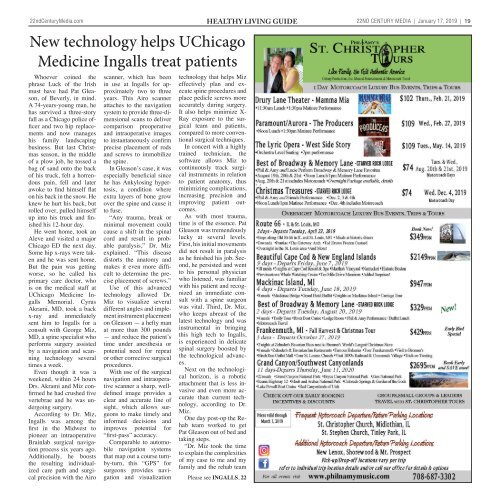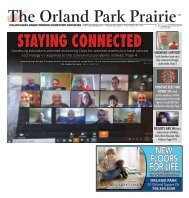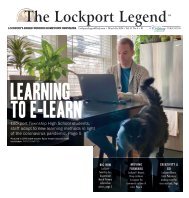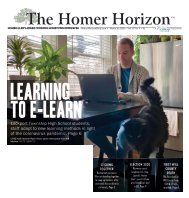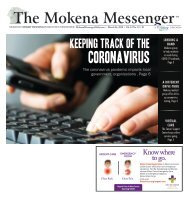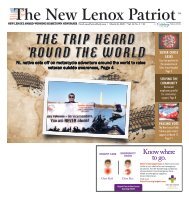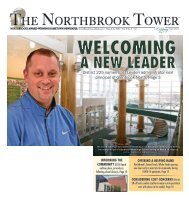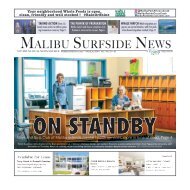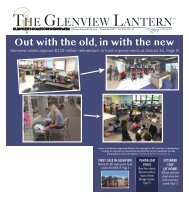Create successful ePaper yourself
Turn your PDF publications into a flip-book with our unique Google optimized e-Paper software.
22ndCenturyMedia.com Healthy Living guide<br />
22nd century media | January 17, 2019 | 19<br />
New technology helps UChicago<br />
Medicine Ingalls treat patients<br />
Whoever coined the<br />
phrase Luck of the Irish<br />
must have had Pat Gleason,<br />
of Beverly, in mind.<br />
A 74-years-young man, he<br />
has survived a three-story<br />
fall as a Chicago police officer<br />
and two hip replacements<br />
and now manages<br />
his family landscaping<br />
business. But last Christmas<br />
season, in the middle<br />
of a plow job, he tossed a<br />
bag of sand onto the back<br />
of his truck, felt a horrendous<br />
pain, fell and later<br />
awoke to find himself flat<br />
on his back in the snow. He<br />
knew he hurt his back, but<br />
rolled over, pulled himself<br />
up into his truck and finished<br />
his 12-hour day.<br />
He went home, took an<br />
Aleve and visited a major<br />
Chicago ED the next day.<br />
Some hip x-rays were taken<br />
and he was sent home.<br />
But the pain was getting<br />
worse, so he called his<br />
primary care doctor, who<br />
is on the medical staff at<br />
UChicago Medicine Ingalls<br />
Memorial. Cyrus<br />
Akrami, MD, took a back<br />
x-ray and immediately<br />
sent him to Ingalls for a<br />
consult with George Miz,<br />
MD, a spine specialist who<br />
performs surgery assisted<br />
by a navigation and scanning<br />
technology several<br />
times a week.<br />
Even though it was a<br />
weekend, within 24 hours<br />
Drs. Akrami and Miz confirmed<br />
he had crushed five<br />
vertebrae and he was undergoing<br />
surgery.<br />
According to Dr. Miz,<br />
Ingalls was among the<br />
first in the Midwest to<br />
pioneer an intraoperative<br />
Brainlab surgical navigation<br />
process six years ago.<br />
Additionally, he boosts<br />
the resulting individualized<br />
care path and surgical<br />
precision with the Airo<br />
scanner, which has been<br />
in use at Ingalls for approximately<br />
two to three<br />
years. This Airo scanner<br />
attaches to the navigation<br />
system to provide three-dimensional<br />
scans to deliver<br />
comparison preoperative<br />
and intraoperative images<br />
to instantaneously confirm<br />
precise placement of rods<br />
and screws to immobilize<br />
the spine.<br />
In Gleason’s case, it was<br />
especially beneficial since<br />
he has Ankylosing hypertosis,<br />
a condition where<br />
extra layers of bone grow<br />
over the spine and cause it<br />
to fuse.<br />
“Any trauma, break or<br />
minimal movement could<br />
cause a shift in the spinal<br />
cord and result in probable<br />
paralysis,” Dr. Miz<br />
explained. “This disease<br />
distorts the anatomy and<br />
makes it even more difficult<br />
to determine the precise<br />
placement of screws.”<br />
Use of this advanced<br />
technology allowed Dr.<br />
Miz to visualize several<br />
different angles and implement<br />
instrument placement<br />
on Gleason — a hefty man<br />
at more than 300 pounds<br />
— and reduce the patient’s<br />
time under anesthesia or<br />
potential need for repeat<br />
or other corrective surgical<br />
procedures.<br />
With use of the surgical<br />
navigation and intraoperative<br />
scanner a sharp, welldefined<br />
image provides a<br />
clear and accurate line of<br />
sight, which allows surgeons<br />
to make timely and<br />
informed decisions and<br />
improves potential for<br />
“first-pass” accuracy.<br />
Comparable to automobile<br />
navigation systems<br />
that map out a course turnby-turn,<br />
this “GPS” for<br />
surgeons provides navigation<br />
and visualization<br />
technology that helps Miz<br />
effectively plan and execute<br />
spine procedures and<br />
place pedicle screws more<br />
accurately during surgery.<br />
It also helps minimize X-<br />
Ray exposure to the surgical<br />
team and patients,<br />
compared to more conventional<br />
surgical techniques.<br />
In concert with a highly<br />
trained technician, the<br />
software allows Miz to<br />
continuously track surgical<br />
instruments in relation<br />
to patient anatomy, thus<br />
minimizing complications,<br />
increasing precision and<br />
improving patient outcomes.<br />
As with most trauma,<br />
time is of the essence. Pat<br />
Gleason was tremendously<br />
lucky at several levels.<br />
First, his initial movements<br />
did not result in paralysis<br />
as he finished his job. Second,<br />
he persisted and went<br />
to his personal physician<br />
who listened, was familiar<br />
with his patient and recognized<br />
an immediate consult<br />
with a spine surgeon<br />
was vital. Third, Dr. Miz,<br />
who keeps abreast of the<br />
latest technology and was<br />
instrumental in bringing<br />
this high tech to Ingalls,<br />
is experienced in delicate<br />
spinal surgery boosted by<br />
the technological advances.<br />
Next on the technological<br />
horizon, is a robotic<br />
attachment that is less invasive<br />
and even more accurate<br />
than current technology,<br />
according to Dr.<br />
Miz.<br />
One day post-op the Rehab<br />
team worked to get<br />
Pat Gleason out of bed and<br />
taking steps.<br />
“Dr. Miz took the time<br />
to explain the complexities<br />
of my case to me and my<br />
family and the rehab team<br />
Please see ingalls, 22


